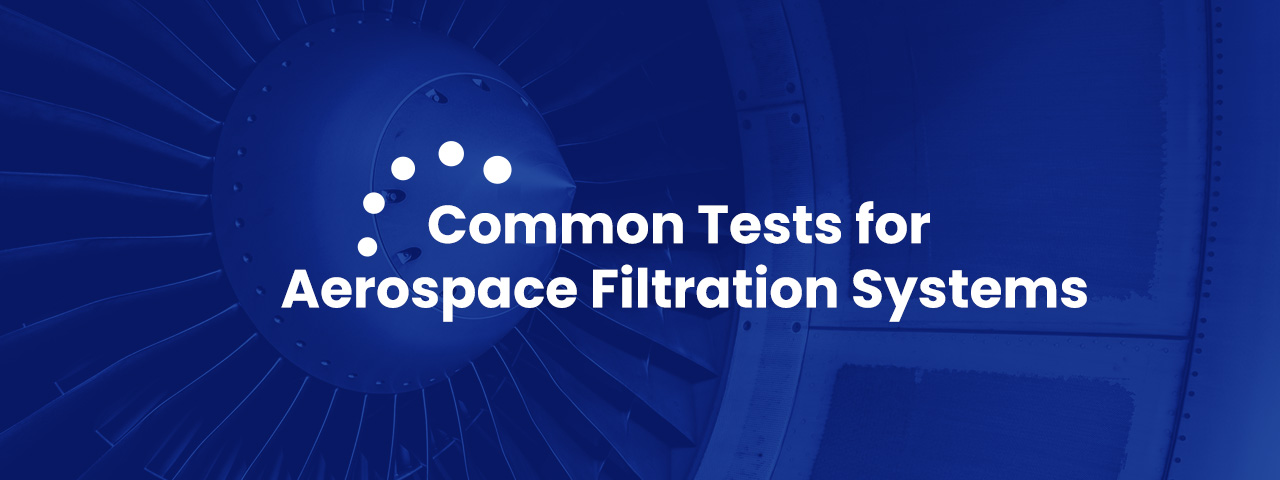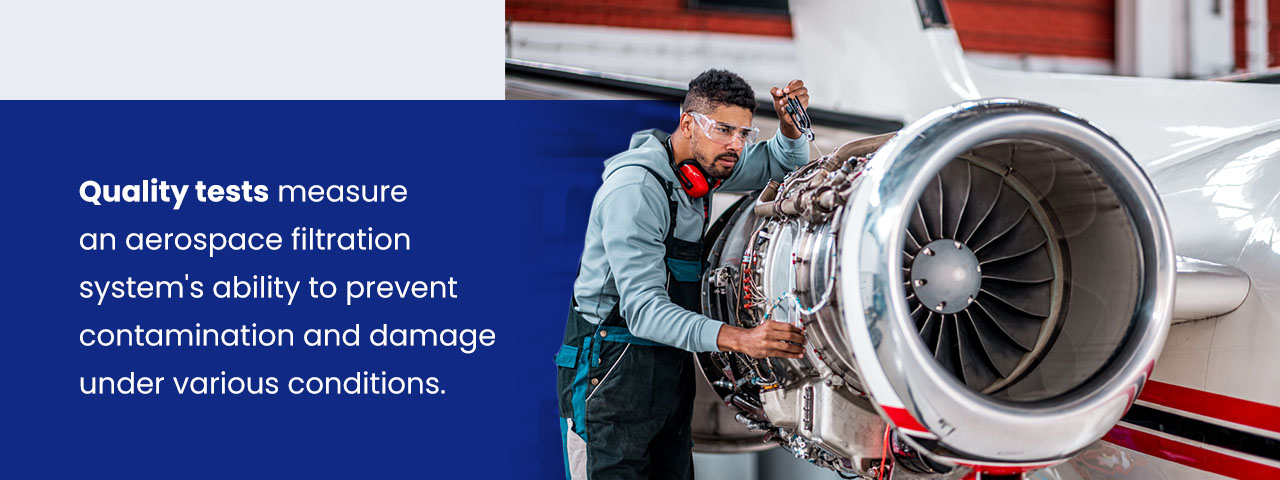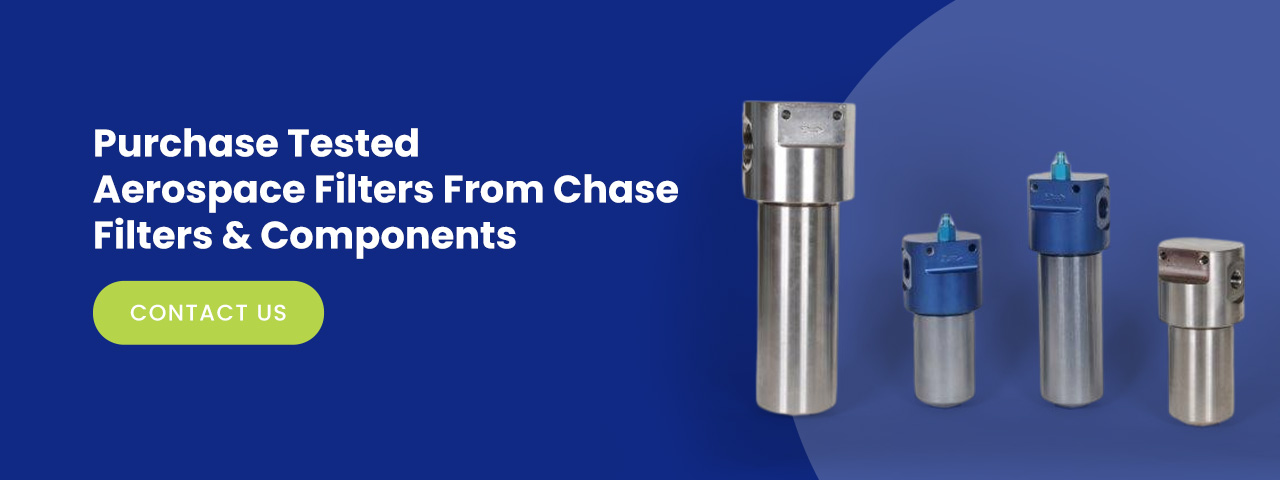January 12, 2024
Common Tests for Aerospace Filtration Systems

Jump To:
- Importance of Aerospace Filtration System Testing
- Quality Tests for Aerospace Filtration Systems
- Separation Efficiency, ISO-14085-3; 2015
- Dirt-Holding Capacity, ISO-16889
- Dirt Loading, ISO-3968
- Bubble Point, ARP-901
- Pressure Differential, ISO-2941
- Thermal Flow
- High-Flow Testing
- Flow Fatigue Resistance, ISO-3724
- Differential Pressure Versus Flow
- Fluid Compatibility
- Cryogenic Sealing
- Hydraulic Fluid Power
- Ignition, ASTM-G175
- Available Aerospace Filters
Aerospace filtration testing is essential because it ensures aircraft filters perform correctly under all possible conditions. Aerospace filter elements must be able to withstand certain pressure levels, particulate volumes, temperatures, fluids and flow rates. Several tests verify how well aircraft filters can separate contaminants from fluids and perform well in various conditions.
Aircraft performance, safety and longevity depend on proper filtration. Testing processes apply various conditions to filter elements to ensure they can effectively protect aircraft parts from corrosion and system failure. Learn more about testing for aerospace filtration systems.
Importance of Aerospace Filtration System Testing
Aerospace filtration systems ensure filters perform properly to prevent damaging particulates from entering aircraft. Aerospace filter tests determine how well filters can trap contaminants in various conditions such as pressure differentials, high temperatures and high dirt volume.
Thorough testing verifies filters meet the required efficiency and capacity specifications. It also provides the data necessary to compare filters and choose the best options for various aircraft. Filtration system testing helps to extend aircraft life cycles because it ensures filters can effectively minimize erosion and prevent hydraulic, fuel and oil lubrication systems from failing.
Filtration system testing is crucial in the aerospace industry because it ensures filters meet International Organization for Standardization (ISO) standards. With the right filters, you can operate your aircraft safely and avoid in-flight damage, flight delays for repairs, system failures and accidents.
Quality Tests for Aerospace Filtration Systems
Quality tests measure an aerospace filtration system’s ability to prevent contamination and damage under various conditions. To understand more about filtration standards and how to choose the best options, consider the following common tests for aerospace filters:
Separation Efficiency, ISO-14085-3; 2015
A separation efficiency test reveals how well an aerospace filter separates damaging particulates from fluids. A filtration system’s pores control how efficiently it can separate contaminants from an aircraft’s fluid. This test helps determine which filter can best separate a specific particulate size from your aircraft fluids.
Dirt-Holding Capacity, ISO-16889
Dirt-holding capacity tests determine how efficiently aerospace filters hold dirt. During a dirt-holding capacity test, various contaminants flow through a filter to measure how much dirt the filter can hold. A filter’s maximum dirt-holding capacity is how much dirt it can hold without hindering filtration quality. There is a count on particles added to the test and a downstream particle count to see what was removed and give you the Beta Ratio or element efficiency.
Dirt Loading, ISO-3968
A dirt loading test is similar to a dirt holding capacity test. During this test, a tester adds fine dust to a hydraulic filtration system and measures the maximum weight of particulate you can apply to the filter element before it collapses.
Bubble Point, ARP-901
A bubble point test reveals a filter’s maximum pressure pit that allows a continuous bubble flow. Surface tension and capillary pores trap fluid. This test applies gas to the filter’s wet side to measure the minimum applied pressure necessary for fluid to flow through the pores.
A bubble point test measures the absence of bubbles to verify a filter element’s integrity. It also identifies the filter element’s first bubble point to locate its largest pore.
Pressure Differential, ISO-2941
Pressure differential tests measure how efficiently aerospace filters perform at different pressure levels. Pressure is measured in pounds per square inch (PSI), and various filters are expected to perform well under different PSI levels.
During a pressure differential test, a tester pumps contaminated fluid through a filter until they reach the expected maximum differential pressure level without filtration failure. If the filter bursts or collapses before the pressure reaches the expected maximum level, it does not meet ISO standards.
Thermal Flow
Thermal flow tests measure pressure differential and temperature restrictions. A thermal flow test measures the maximum fluid temperature a filter can endure.
High-Flow Testing
High-flow testing simulates a rocket propulsion system’s flow through a filter. It determines capabilities for low-pressure differentials and a filter’s volumetric flow rate.
Flow Fatigue Resistance, ISO-3724
A flow fatigue resistance test reveals how well a hydraulic filter element resists flow fatigue. During this test, a tester fills the part with particulates. The tester then applies a predetermined terminal differential pressure and a uniform varying flow rate. This process verifies whether a filter can withstand the flexing that variable flow rates and differential pressures cause. This test determines whether filter elements meet ISO 3724 standards.
Differential Pressure Versus Flow
ISO 3968 outlines the process for testing a hydraulic filter’s differential pressure versus flow characteristics. This process also measures how much differential pressure a filter generates at different viscosities and flow rates.
Fluid Compatibility
A fluid compatibility test ensures filter elements are compatible with all of the following fluids:
- Water glycols
- High water base fluids
- Petroleum oils
- Synthetic fluids
- Oil and water emulsions
Cryogenic Sealing
A cryogenic sealing test submerges a filter into liquid nitrogen and allows the filter to soak until all surfaces reach a certain soak temperature. Testers then conduct a helium leak test at the soak temperature to ensure the seal operates properly.
Hydraulic Fluid Power
ISO 16889 outlines the testing method that determines a filter element’s Beta ratio or overall efficiency at a stated micron rating. This performance test is a multi-pass process in which a tester continuously injects contaminants to establish how efficiently the element can capture the contaminants.
Ignition, ASTM-G175
Ignition testing ensures aerospace oxygen filters are ignition-resistant. This test is crucial because it verifies that a filter is safe and will not ignite under any conditions.
Available Aerospace Filters
Aircraft depend on reliable filtration systems. You can operate your aircraft safely and efficiently with the following filters:
- 52 Series T-type filters: 52 Series filters remove contaminants from systems with an operating pressure of 20,000 PSI and a flow that reaches 24 gallons per minute (GPM).
- 51 Series T-type filters: 51 Series filters maintain clean fluid in ground support equipment and ensure systems comply with safety and purity standards. These filters can handle 6,000 PSI and a flow of up to 50 GPM.
- 50 Series Tee-type filters: 50 Series filters remove impurities from high-pressure oxygen equipment. They can handle 6,000 PSI.
- 41 Series mini Tee-type filters: 41 Series filters remove particles such as dirt, rust and scale from hydraulic fluids. A 41 Series filter can handle 10,000 PSI and a flow rate of up to 1.5 GPM.
- 33 Series in-line filters: 33 Series filters remove particles from fluid and can handle operational pressure up to 30,000 PSI and flow rates up to 2.5 GPM.
- 31 Series in-line filters: 31 Series filters protect hydraulic fluids from contaminants so systems can operate smoothly. These filters use high pressure to keep systems free of harmful particulates. These filters can handle 6,000 PSI and up to 40 GPM.
- 30 Series brass in-line filters: 30 Series filters remove contaminants from oxygen systems with operating pressures up to 6,000 PSI.
- 25 Series aerospace filters: 25 Series filters remove contaminants that can pose health risks and damage equipment. This high-pressure oxygen filter has passed a rigorous ignition test to ensure it is ignition-resistant. These filters can handle 6,000 PSI.
- 23 Series mini in-line filters: 23 Series filters eliminate contaminants in various systems and can handle up to 6,000 PSI and up to a 5 GPM flow rate.
- 22 Series mini in-line filters: 22 Series filters remove contaminants in various commercial applications. They can handle flow rates up to 2.5 GPM and a PSI of up to 6,000.
- 21 Series mini in-line filters: 21 Series filters eliminate particulates in hydraulic fluids with a PSI of up to 6,000 and flow rates of up to 5 PSI.
- 20 Series mini in-line filters: 20 Series filters are compact and easily adaptable. They remove contaminants from high-pressure oxygen systems and can handle an operating pressure of 6,000 PSI.
Purchase Tested Aerospace Filters From Chase Filters & Components
Filtration system testing is crucial in the aerospace industry. Proper testing ensures filters can perform effectively under all expected conditions and reveals which systems have the best filtration. When you use well-tested filters in your aircraft, you can expect a reliable system that provides clean fluid, improved performance and an extended system life span.
Chase Filters & Components offers high-quality filtration systems for the aerospace industry. Our well-tested filters provide dependable performance so you can trust your aircraft and equipment are protected from harmful particulates. Contact us to learn more about our aerospace filters and find the right products for your aircraft and equipment.

